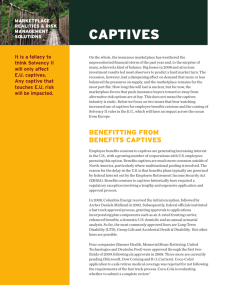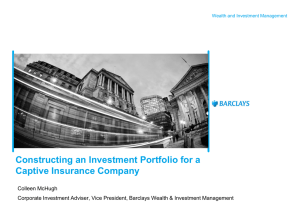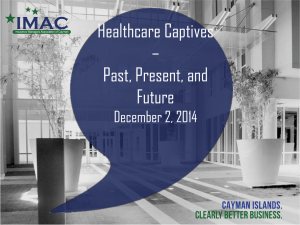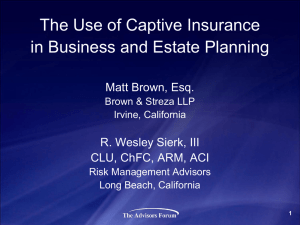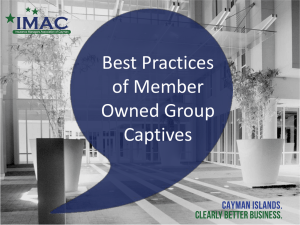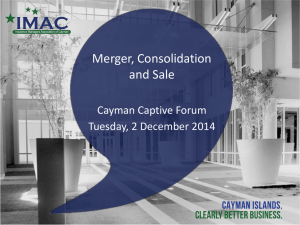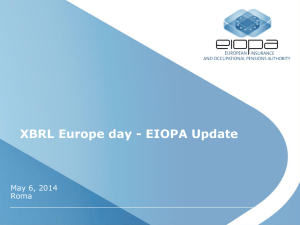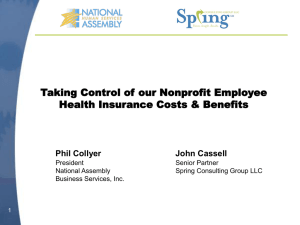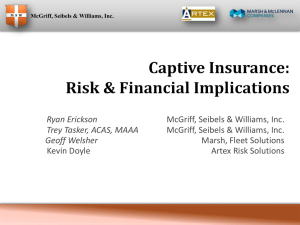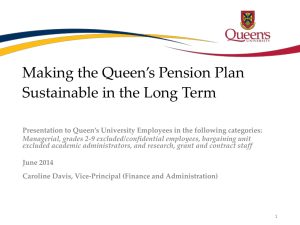17-06-14-AIRMIC-Workshop-v2
advertisement
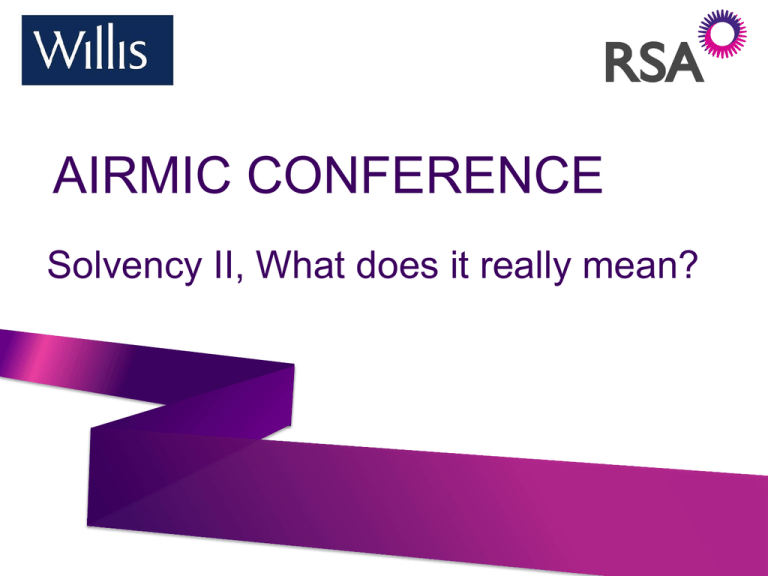
AIRMIC CONFERENCE Solvency II, What does it really mean? Sue Loney Casualty Underwriting Director, RSA Angus Jordan UK MI & Solvency II Director, RSA Seamus Gallagher Director of Consulting, Willis Global Captive Practice Nigel Goodlad Managing Director, Willis Management (Malta) Limited AGENDA What is Solvency II? RSA’s approach to Solvency II compliance Willis - Solvency II impact on Captives From what you know at the moment about the increased level of disclosure, the greater uniformity of reporting and potential impacts for captives, “Is SII a good thing for a Risk Manager"? What is Solvency II? By Angus Jordan RSA, UK MI & Solvency II Director • Pan-European regulatory regime for capital adequacy - effective from Jan 2016 • Evaluation of capital levels tailored to the risks within the organisation • Requires firms to have in place an effective risk management and governance system What is Solvency II? Better risk based • Change to the basis of calculating insurance management of Capital liabilities for all insurers with assets and liabilities valued on a market consistent basis • Firms can use either a standard formula or a bespoke internal model to calculate capital requirements Greater clarity for customers and investors • Internal models subjected to stringent tests before approval and must be integrated to the business • Increase in regulatory reporting requirements both in terms of content and reduced timescales 6 Standard Formula (SF) • The Standard Formula is being developed by the European Commission and EIOPA • Generic “one size fits all” model geared towards smaller businesses • To date there have been issues with overly What is Solvency II? prudent calibrations • Overly complex although simpler than using an internal model. Anticipate higher capital requirements because it does not properly allow for diversification Companies may calculate solvency capital requirements using a standard formula The Formula! 1 ( net ,s ) M ( net ,s ) 2 NPs where 1 ( gross,s ) M ( gross,s ) 2 M ( gross ,s ) 1 Fm 2 , a s bs Fm 2 , a s a s Fm , a s bs Fm , a s M ( net ,s ) b 1 F a b m , s s s ( net ,s ) (2gross,s ) M (2gross,s ) 1 Fm 2 2 , a s bs Fm2 2 , a s a s2 Fm , a s bs Fm , a s 2bs M ( gross,s ) 1 Fm 2 , a s bs b 2 1 F a b M 2 m , s s ( net , s ) s 1/ 2 7 Stochastic Model Trials 1 Probability What is Solvency II? 1,000 25,000 Impact £30m £40m £50m £100m Internal Model (IM) • In our case that means basing a model on our existing Individual Capital Assessment (ICA) models already implemented throughout the RSA Group • Tailored to the company’s business and risk profile • Anticipate that IM will result in lower capital requirements – although there are a number of minimum floors to consider • Model will have to be integrated into the business at an entity level Alternatively companies may calculate solvency capital requirements using a bespoke internal model Process managed via an Internal Model Approval Process (IMAP), which is still developing in many locations. This shouldn’t be underestimated in its rigour and requirements in terms of both time and amount of documentation. ANNUAL REPORTS Regular Supervisory Report (RSR) What is Solvency II? Akin to the existing ICA report. This is not public and holds more detailed disclosures enabling analysis of our Solvency position - @ 250 pages per entity here alone! Own Risk and Solvency Assessment (ORSA) As part of the risk management system this report gives an assessment of solvency needs of the specific undertaking, demonstrate compliance with the SCR and monitor assumptions in the SCR against actual risk profile. This is not public Solvency and Financial Conditions Report (SFCR) This is a new public report disclosing information regarding our solvency position – around another 100 pages here (Annual) Quantitative Reporting Templates (QRT’s) 56 forms, some multiplied by each LoB for Claims and major currency development triangles NEW QUARTERLY REPORTS ARE INTRODUCED Quarterly Quantitative Templates (QRT’s) Again by Entity. Another 17 forms here 9 Requires firms to have in place an effective risk management and governance system 10 RSA’s approach to Solvency II compliance By Angus Jordan RSA, UK MI & Solvency II Director • Set up a Group Programme sponsored by both the Group Risk and Finance Directors, with series of Regional Programmes – not just in the EEA! • Proactive involvement with EIOPA, the PRA, the ABI and our College of Regulators • Embedded the Risk Management system further in the business with explicit Risk Appetites and Risk Tolerances applied How has RSA runs it’s programme to implement Solvency II? • Participated in all 5 Quantitative Impact Studies (QIS) and we are now engaged in the EIOPA Stress tests • Undertook an Entity Simplification programme, removing 18 Regulated Insurance Entities • We are applying for Internal Model Approval for the principal entities but not necessarily in all cases • Significant investment in Technology programmes – mostly about automating production of reconciled data in a timely enough manner. (Like many others, took the opportunity to invest in wider reporting processes) 12 PROGRAMME HAS BEEN RUNNING SINCE 2010 • Long way down the line of Remediation (notwithstanding the lack of clarity at times partial mothball along the way) ... but not yet finished Where are we now? • Re-running Gap Analysis activity against updated text • Already seeing considerable changes in the UK, with the PRA now looking at what we have termed "ICA Plus" type reporting • Engaged in active discussions in connection with IMAP, theoretical decision of lead regulator but the reality is that we have to talk and present to multiple regulators, even though we run a central model • Many elements now moving into BAU process, with the Reporting going through varying stages of testing and dry runs under increasingly tighter and SII Compliant timetables 13 Where are we now? IMAP 2014 2015 SII 2016 2017 EIOPA • Annual QRT of 2014 year end data to be delivered in July 2015 • Quarterly QRT’s for Q3 2015 • First full Annual reporting Q1 2017 based on Year End 2016 data 14 SII IMPACT ON CAPTIVES Seamus Gallagher, Director of Consulting, Willis Global Captive Practice Nigel Goodlad, Managing Director, Willis Management (Malta) Limited OUTLINE Which captives are affected? What is required of EU captive owners and by when? Impact on Capital, Governance and Reporting (Pillars 1, 2 and 3) How prepared are captive owners? Which areas are causing concern? Ways of mitigating capital requirements What support can you expect from your captive manager? Is SII positive or negative for captive owners? 16 16 EU CAPTIVES Which captives are affected? Directly subject to Solvency II regulation in each EU domicile Reinsurance to unrated reinsurers in non-SII equivalent domiciles will be penalised by large counterparty charge in SII capital formula OFFSHORE CAPTIVES (predominantly favoured by AIRMIC members) Not directly affected as most domiciles have opted out of SII (but are introducing other forms of riskbased capital rules) Will offshore regulation be seen as “too light” compared to SII? Probably not: - Still need to conform to IAIS Core Principles, but perhaps with more proportional approach being taken by regulators 17 2014 What is required of EU captive owners and by when? 2015 2016 Required: Required: Required: Forward Looking Assessment of Own Risk (FLAOR) Implementation of Functions: Pillar 1 (Capital): System of Governance and Risk Management Optional: Updated Standard Model Calculation of Capital Requirements (recommended) • • • • Actuarial Risk Compliance Internal Audit Implementation of Forward Looking Assessment of Own Risk (FLAOR) Preparation for Pillar 3 Reporting Requirements • Capital and Solvency Calculations in accordance with technical specifications Pillar 2 (Governance): • Implementation of System of Governance • Actuarial Function • Risk Function • Compliance Function • Internal Audit Function • Own Risk and Solvency Assessment (ORSA) Pillar 3 (Reporting): • Reporting on quarterly basis for MCR and SCR Capital Requirements 18 Solvency II example capital analysis SCR 6,066 Adj 0 Market BSCR 5,541 Default 17 2,233 Operational 525 Non-Life Underwriting 4,071 Interest rate 16 Premium & Reserve 3,111 Currency Catastrophe 1,961 0 Spread 0 Concentration 0 Illiquidity 5 Capital Available Capital Requirement Excess/ (Shortfall) Solvency ratio Solvency I 11,561 4,375 7,186 264% MQIS5 11,432 6,066 5,366 188% 19 19 FLAOR – As part of Pillar 2 Risk Management Function Where does the FLAOR fit in the overall Solvency II project? Risk Management Strategy & Appetite Capital Management Decisions Board of Directors UW Policy Reinsurance Policy Op Risk Policy Strategic Risk Policy Liquidity Risk Policy ALM Policy Investment Policy FLAOR Process Controls Risk Register FLAOR | 20 INDUSTRY EXPERIENCE Capital Impact (Pillar 1) - 20% were below 75% of the SCR Impact of Quantitative Impact Study 5 (QIS5) on capital levels ECIROA 2011 study – 132 EU captives reviewed: - 30% were below 100% of the Solvency Capital Requirement (SCR) EIOPA 2011 – survey of 175 captives found that they “performed well” WILLIS EXPERIENCE QIS5’s completed in late 2010 on a small sample: - Almost 50% were projected to have a capital shortfall, but many have addressed this since - Property captives fared worse than liability captives due to impact of SII capital formula on typical captive structures (large gross lines with very substantial reinsurance) 2121 Governance Impact (Pillar 2) Captive owners must convince regulators that governance arrangements are adequate Principle of proportionality will be applied by regulators: - All have accepted outsourcing of most tasks to captive managers (with appropriate board oversight) - Some have acknowledged that certain captives are not complex and low-risk and the framework can be proportionate to this Additional workload will increase costs Captive owners are required to assess and understand risks, to document and implement governance frameworks Preparation of FLAOR’s and ORSA’s requires some input from captive owners, but not unduly onerous with managers’ help 22 22 Reporting Impact (Pillar 3) Reporting requirements are inevitably more onerous for a risk-based capital regime (60+ reporting templates), but again proportionality implies that less complex captives will have fewer templates to complete:0 - for example, reporting for a monoline captive with simple investment arrangements will not be overly demanding Captive managers are implementing systems to automate the reporting process - this granularity could help captives in the long run 23 23 How prepared are captive owners? Well informed by captive managers and good understanding of what SII is about Expect increased activity to ensure conformance as Jan 1 2016 date looms Most have started in earnest on QIS5 capital adequacy assessments and many have taken action in response to the findings Work in relation to Pillar 2, governance arrangements, is in progress In relation to Pillar 3, reporting, managers are undertaking gap analyses on client data to assess current versus required reporting 24 24 Which areas are causing concern? SII principles and processes are generally acknowledged and accepted The need to implement systems and process with attendant costs is understood Extensive reporting requirements are a concern, but expectation is that captive manager will provide almost all of the services, subject to proper board oversight Questions have been raised that public disclosure of reporting could entail requirements that are not fully known at this stage Potential capital impact may be the most immediate concern 25 25 Move from EU to Offshore Ways of mitigating capital requirements o Industry indications imply moves are negligible to date o No Willis clients have moved offshore due to SII, although some have restructured o Poor economy has driven strategic reviews, not SII in isolation Restructure Reinsurance o Counterparty Default Risk charge can be punitive unless addressed o Applying minimum ratings for counterparties (e.g. minimum A- rating) or use additional reinsurers to diversify can dramatically reduce default charge o For particularly large exposures, e.g. where high limits are written on property insurance, replacing captive reinsurance arrangements with net lines to captive without reinsurance – removes any counterparty concerns Restructure Investments o Low-risk investments (e.g. AAA rated, bond or money- market type instruments) achieve larger capital credit Restructure Capital o More creative use of Tier 2 and 3 options, for example unpaid capital o Up to 50%/15% of the SCR can be in Tier 2/Tier 3 funds 26 26 What support can you expect from your captive manager? Captive managers work in tandem with boards – developing and implementing policies and frameworks and ensuring continued management of the compliance programmes Captive boards are ultimately responsible for compliance, but with proper oversight can delegate most tasks to the captive managers Captive managers can normally be expected to provide all SII services except Internal Audit 27 27 Is SII positive or negative for captives? Provided that the new regulatory framework is proportionate to the nature, scale and complexity of captives, SII should ensure that captives are appropriately capitalised with enhanced oversight and governance SII regulations will require EU captive owners to invest more time assessing, understanding and managing risks, but most of the work can be outsourced to captive managers subject to boards retaining ultimate oversight and responsibility Regulators in many captive domiciles (not just in the EU) are implementing more robust risk-based capitalisation and governance frameworks, which should ultimately benefit the captive industry provided that they are not unduly onerous 28 28 From what you know at the moment about the increased level of disclosure, the greater uniformity of reporting and potential impacts for Captives, “Is SII a good thing for a Risk Manager"? Q&A Thank you!
